Bright underwater inhabitants (18 + 4 photos video)
 Bashny.Net
Bashny.Net
Cancer - mantis (Odontodactylus scyllarus), also known as mantis shrimp harlequin or Shrimp - mantis Pavlinova - belongs to the order of crustaceans.
These beings are endowed with an excellent vision and the ability to move quickly.
They are excellent hunters, who see prey better than special military equipment and stabbed the victim with a .22 caliber bullet force.

Somehow Roy Caldwell, a professor of biology at the University of California at Berkeley, decided to show them one journalist. There, they say, we have here in the aquarium strange, almost unexplored creatures that lurk in coral reefs. Caldwell ran a hand over glass - and suddenly it shattered with a bang. 150 liters of water poured into the laboratory. 30-inch aquarium inhabitants could not stand provocation and with one blow smashed glass.
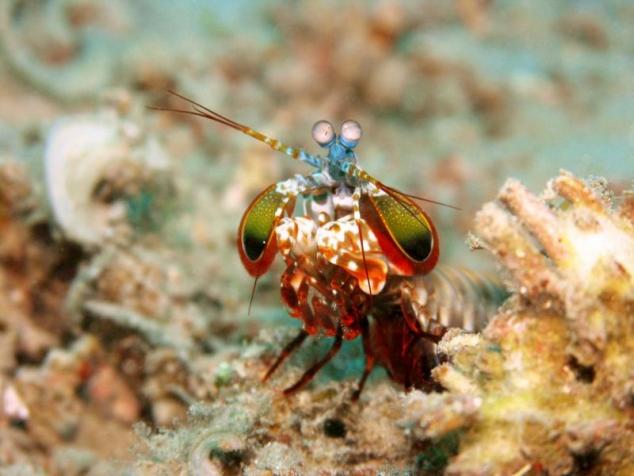
Militant crustaceans earned notoriety. They are called Rumble cancers, bullies, murderers, terrorists crabs. Officially, this is not the peaceful inhabitants of the underwater kingdom is called cancer-mantis. Its name to the sea bully obliged one of the pairs of their maxillipeds - the second front. With their help, crayfish pummel opponents hit a monstrous force. Maxillipeds segments bent at a hair's breadth, as in insects mantis. And just like praying mantises, these animals are able to instantly throw the limb forward to seize the prey. "Blow insect praying mantis takes about 100 milliseconds. At this rate we blink, - says Roy Caldwell. - A mantis shrimp has about 50 times faster! This is one of the fastest movements, which are generally capable of animals ».

Cancer - mantis very colorful and highly intelligent predators living in the coral reefs of tropical and subtropical waters of the ocean. They can be seen at a depth of 2 to 70 meters.
Mantis shrimp play an important role in the ecosystem of reefs, controlling their populations and species. They are also a good bioindicator and, since it is very sensitive to pollution, which makes them an important barometer of the health of coral reefs.
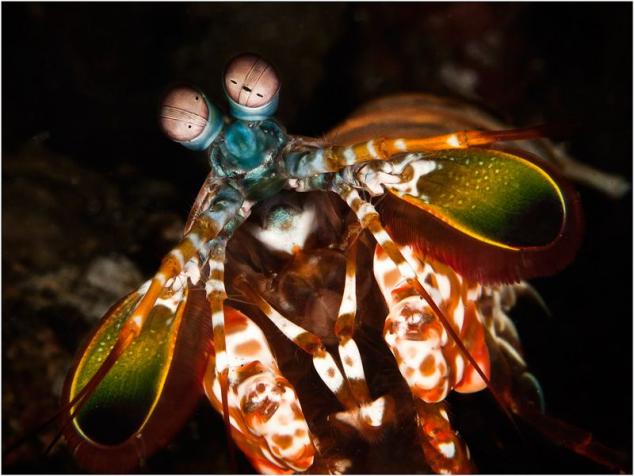
There are more than 450 kinds of cancers - mantis adult size in the range from 2 to 40 cm, although the vast majority of these cancers has a size of 4 to 10 cm. At the time of their call Mantis shrimp strangeness is that they reality are neither shrimp nor mantises, their proper name - stomatopods
Crayfish - mantises have cute appearance, but especially no mistake: stomatopods are aggressive, lonely crustaceans that spend most of their time in a hole and tend to come out of their hiding places only for hunting, moving, or to find a mate. < br />

Crayfish - mantis divided into two groups "vanquishers" and "Lacerator" depending on the structure of the second pair of maxillipeds, which can be used as a stick or spear. If you look closely at the structure of the second pair, we see that it consists of three main segments.
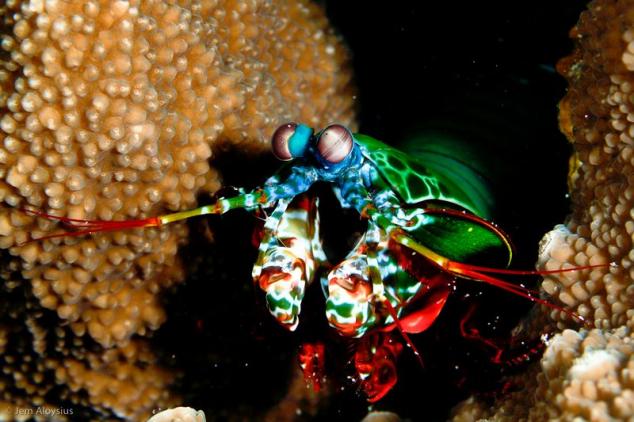
Last segment of the "Lacerator" - a sharp, serrated, like a blade and is embedded in a longitudinal groove of the penultimate segment as a penknife.
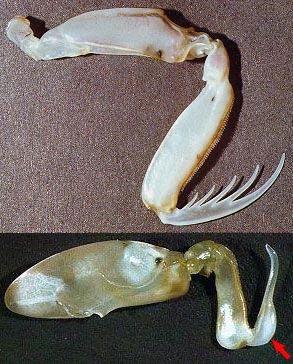
The "Crushers" - the last island segment has a hooked shape, but its base has a seal, which is used for crushing animals with solid covers, such as crabs, bivalves and gastropods.
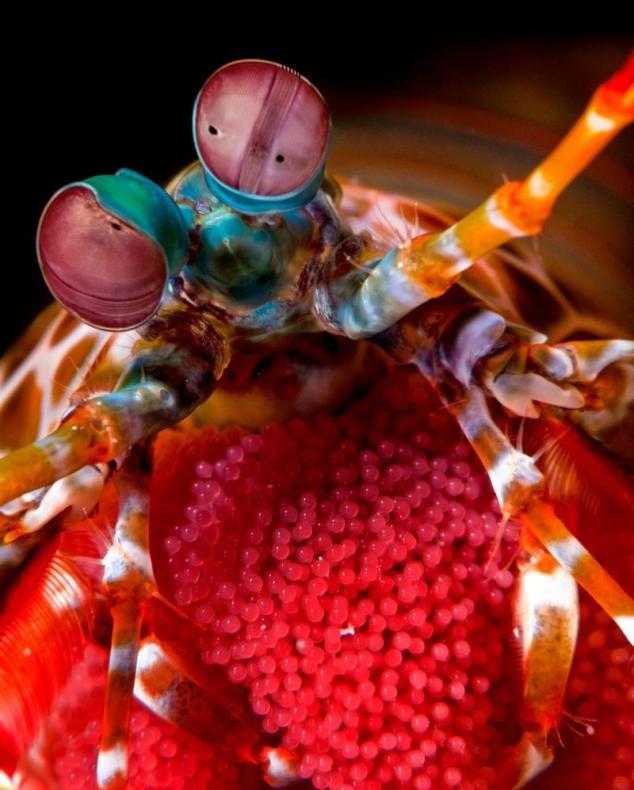
There are certain common behavioral differences between the two groups. Crusher usually live in burrows or rock crevices, and can chase prey.
While "Lacerator" tend to hide in burrows that they dig into soft ground such as sand or mud. Rapid ejection of grasping feet can reach speeds of 10 m / s and is accompanied by the incredible accuracy of hitting the target, so even fish swim past at high speed, is caught or killed.
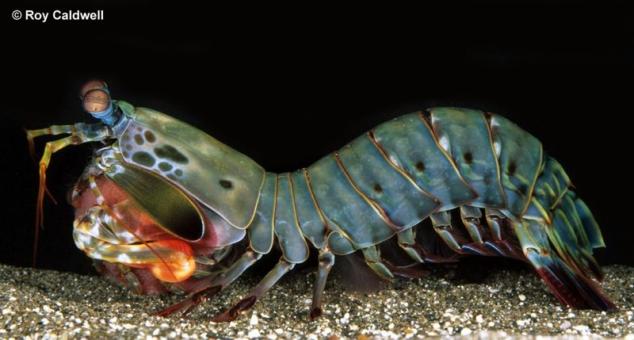
In humans, there are two types of photoreceptor cells and four visual pigment in the eyes, to compare cancer - mantis can have up to sixteen different types of photoreceptors, twelve of which are responsible for color vision in red and ultraviolet regions, and four that analyze polarized light. Their eyes are mounted on the stems, which move independently of each other.
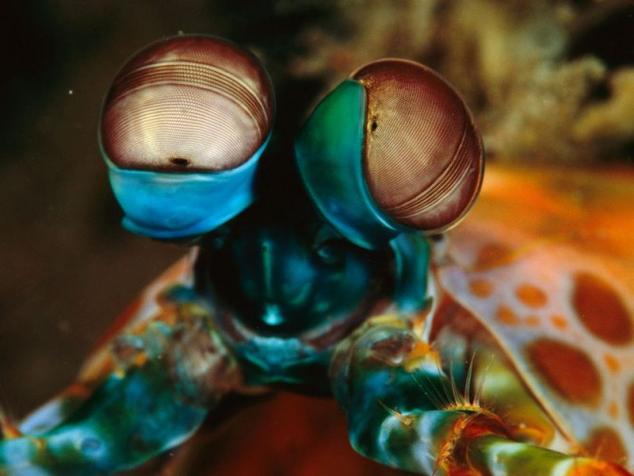
Some cancers - mantises mate randomly, while others are monogamous, and can breed for twenty years without changing partner. Some species lay two clutches of eggs, and every parent takes care of his own progeny, whereas other species, males hunt, while the female cares for the eggs.
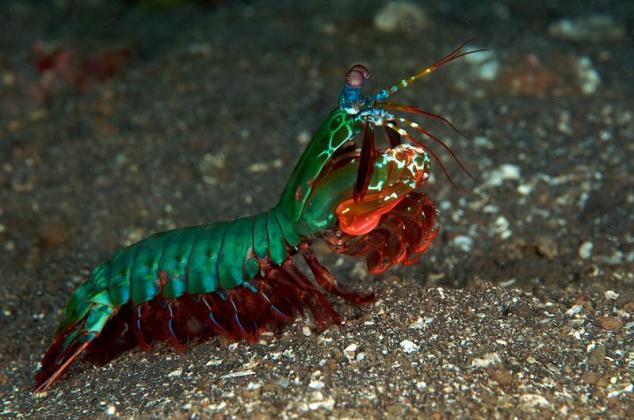
If mantis shrimp directs his gun at the man often ends the matter seriously injured. What can we say about the shallow marine life. Close and distant relatives stomatopods kill with one blow. "In the evolution of mantis shrimps, says Caldwell, had his" arms race ", and in the course of its means of attack ahead of all remedies." Crayfish became larger, combat capability, and increasing the power of the impact is not withstand their own chitinous integument.
Now mantis arms allows them to quietly kill individuals of their own species. Therefore, many species are brightly colored: color warns overtakes fear colliding. It's kind of war paint, like the Indians. First mantis tend to "negotiate" and only then begin to fight. Usually they served each other from afar signs: "I bigger than you - get out!" Before you hit, they are rampant posture: lifted and rastopyrivat tentacles to the bright colors were visible even better.



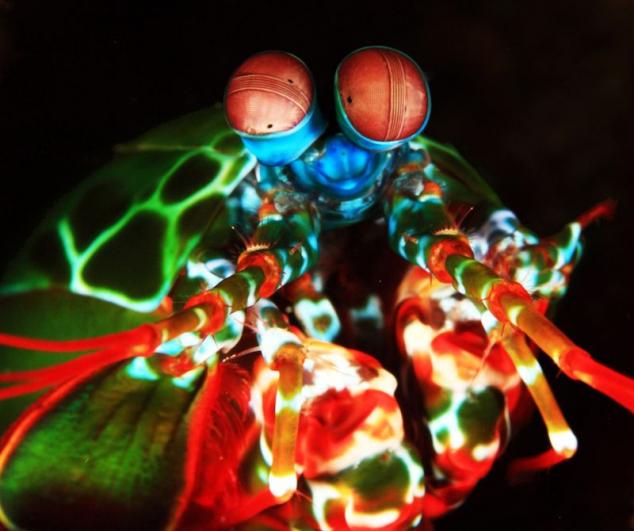

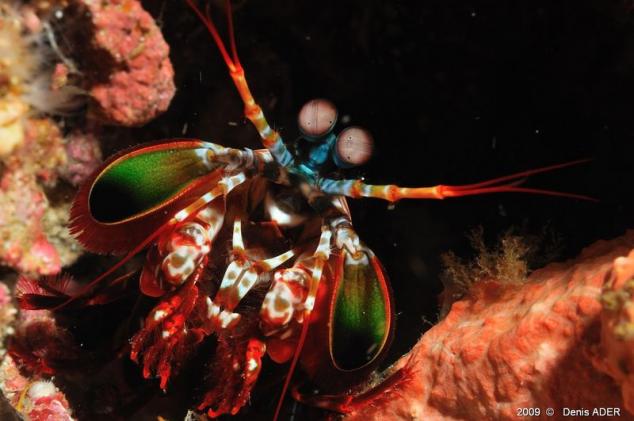
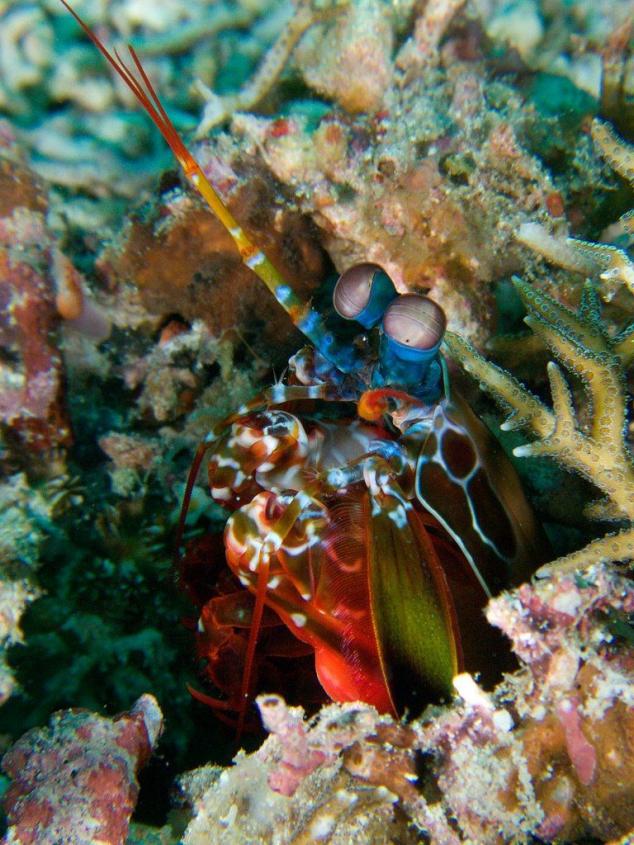
Slow motion video of attack ...
Source: zoopressa.ru, uhtazoo.ru, ianimal.ru, masterok.livejournal.com
These beings are endowed with an excellent vision and the ability to move quickly.
They are excellent hunters, who see prey better than special military equipment and stabbed the victim with a .22 caliber bullet force.

Somehow Roy Caldwell, a professor of biology at the University of California at Berkeley, decided to show them one journalist. There, they say, we have here in the aquarium strange, almost unexplored creatures that lurk in coral reefs. Caldwell ran a hand over glass - and suddenly it shattered with a bang. 150 liters of water poured into the laboratory. 30-inch aquarium inhabitants could not stand provocation and with one blow smashed glass.

Militant crustaceans earned notoriety. They are called Rumble cancers, bullies, murderers, terrorists crabs. Officially, this is not the peaceful inhabitants of the underwater kingdom is called cancer-mantis. Its name to the sea bully obliged one of the pairs of their maxillipeds - the second front. With their help, crayfish pummel opponents hit a monstrous force. Maxillipeds segments bent at a hair's breadth, as in insects mantis. And just like praying mantises, these animals are able to instantly throw the limb forward to seize the prey. "Blow insect praying mantis takes about 100 milliseconds. At this rate we blink, - says Roy Caldwell. - A mantis shrimp has about 50 times faster! This is one of the fastest movements, which are generally capable of animals ».

Cancer - mantis very colorful and highly intelligent predators living in the coral reefs of tropical and subtropical waters of the ocean. They can be seen at a depth of 2 to 70 meters.
Mantis shrimp play an important role in the ecosystem of reefs, controlling their populations and species. They are also a good bioindicator and, since it is very sensitive to pollution, which makes them an important barometer of the health of coral reefs.

There are more than 450 kinds of cancers - mantis adult size in the range from 2 to 40 cm, although the vast majority of these cancers has a size of 4 to 10 cm. At the time of their call Mantis shrimp strangeness is that they reality are neither shrimp nor mantises, their proper name - stomatopods
Crayfish - mantises have cute appearance, but especially no mistake: stomatopods are aggressive, lonely crustaceans that spend most of their time in a hole and tend to come out of their hiding places only for hunting, moving, or to find a mate. < br />

Crayfish - mantis divided into two groups "vanquishers" and "Lacerator" depending on the structure of the second pair of maxillipeds, which can be used as a stick or spear. If you look closely at the structure of the second pair, we see that it consists of three main segments.

Last segment of the "Lacerator" - a sharp, serrated, like a blade and is embedded in a longitudinal groove of the penultimate segment as a penknife.

The "Crushers" - the last island segment has a hooked shape, but its base has a seal, which is used for crushing animals with solid covers, such as crabs, bivalves and gastropods.

There are certain common behavioral differences between the two groups. Crusher usually live in burrows or rock crevices, and can chase prey.
While "Lacerator" tend to hide in burrows that they dig into soft ground such as sand or mud. Rapid ejection of grasping feet can reach speeds of 10 m / s and is accompanied by the incredible accuracy of hitting the target, so even fish swim past at high speed, is caught or killed.

In humans, there are two types of photoreceptor cells and four visual pigment in the eyes, to compare cancer - mantis can have up to sixteen different types of photoreceptors, twelve of which are responsible for color vision in red and ultraviolet regions, and four that analyze polarized light. Their eyes are mounted on the stems, which move independently of each other.

Some cancers - mantises mate randomly, while others are monogamous, and can breed for twenty years without changing partner. Some species lay two clutches of eggs, and every parent takes care of his own progeny, whereas other species, males hunt, while the female cares for the eggs.

If mantis shrimp directs his gun at the man often ends the matter seriously injured. What can we say about the shallow marine life. Close and distant relatives stomatopods kill with one blow. "In the evolution of mantis shrimps, says Caldwell, had his" arms race ", and in the course of its means of attack ahead of all remedies." Crayfish became larger, combat capability, and increasing the power of the impact is not withstand their own chitinous integument.
Now mantis arms allows them to quietly kill individuals of their own species. Therefore, many species are brightly colored: color warns overtakes fear colliding. It's kind of war paint, like the Indians. First mantis tend to "negotiate" and only then begin to fight. Usually they served each other from afar signs: "I bigger than you - get out!" Before you hit, they are rampant posture: lifted and rastopyrivat tentacles to the bright colors were visible even better.







Slow motion video of attack ...
Source: zoopressa.ru, uhtazoo.ru, ianimal.ru, masterok.livejournal.com
Tags
See also
25 free apps that will turn your photos and videos into masterpieces
Underwater Wi-Fi: the United States experience a "deep sea Internet"
Green Snake Manhattan (52 pics + 1 video)
What is not told in the news (10 pics + 3 videos)
Underwater scooter (14 photos)
Amazing underwater photography (18 photos)
My vacation at Cape Tarkhankut (34 pics + 1 video)
Google untied from Google+ Photos and turned into an unlimited storage of photos and videos
Underwater Love (12 pictures)
What is this miracle? (14 pics + 1 video)

















